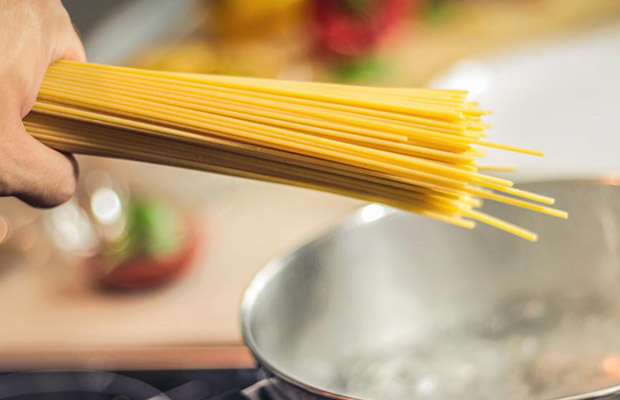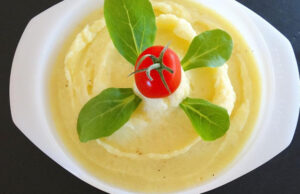One of the first foods many Americans learn to prepare in the kitchen is noodles. Yes, there are subtleties to the art of making and cooking pasta that you might not understand in your early attempts. How do you know when noodles are done?
Nothing is more difficult than carefully removing one of your noodles from the pasta maker and slicing it in half. When you do, you’ll probably notice a ring of spaghetti inside the noodle that is a brighter color than the rest of the pasta. The uncooked pasta is that part of the dish. The less cooked the ring is, the thicker it is.
Table of Contents
How Do You Know When Noodles Are Done?
Avoid throwing them at the wall; that sounds messy. You can avoid biting into a piece of very hot, slightly raw rigatoni by using a simple trick. To cut one of your noodles in half, all you have to do is carefully fish it out of the pasta pot.
You’ll probably notice a ring inside the pasta that is a lighter shade than the rest of the noodle when you do so. The pasta is still raw there. A ring will be less cooked the thicker it is. A thin ring of that lighter color should be present inside al dente pasta. Search for a thicker ring if you prefer your pasta slightly less cooked than al dente. There should be no ring at all on fully cooked pasta.
How Long Do Noodles Typically Need to Cook?
A basic pasta recipe is as follows: In a large saucepan, heat the water to a boil while adding salt and/or olive oil. The pasta should be added to the boiling water and cooked for 8–12 minutes, depending on the type (see above). Pasta should be drained and left to steam dry for a few minutes, or until the surface is matte.
You might be interested: How Do You Make Homemade Noodles in Pillsbury?
If Your Noodles Are Undercooked, How Can You Tell?
How to tell if your pasta is overcooked or undercooked. To determine whether your pasta is overcooked or undercooked before you can treat it if it is overcooked. Pasta that is crisp and firm is typically a sign that it has not been cooked for long enough, whereas pasta that is soft and mushy is typically an indication that it has been overdone.
How to Determine Whether Noodle Is Overcooked or Undercooked?
Depending on the brand, is chewy pasta undercooked or overcooked?
- When you bite into the pasta, if it is hard and crunchy, it is undercooked. Taste it after 30 seconds of cooking to determine when it is finished.
- Al dente pasta is finished when it is tender to the bite but firm to the bite.
- If the pasta is soft and mushy, the pasta is overcooked.
How long Are Dried Egg Noodles Cooked for?
Egg noodles should be cooked until they are al dente in salted boiling water until they are fully cooked. Depending on thickness, freshly made noodles only need to cook for 3 to 5 minutes. Dried noodles will need to be cooked for 8 to 12 minutes.
For Al Dente Noodles, How Long Should You Cook Them?
Freshly made pasta cooks quickly; al dente is attained in just 2 to 3 minutes.
How Do You Fix Overcooked Noodles?
Noodles that are overcooked can be salvaged by putting them in a skillet with some butter or olive oil and cooking them until they are soft and translucent. By slightly crisping them up more, this will enable you to save some of your dinners. The dish will have a little more zip from the addition of garlic or Parmesan cheese, which will also help to hide the overcooked noodle flavor.
You might be interested: What temperature should I use to cook chicken breast on a green egg?
The Correct Way to Cook Noodles
Instructions:
- Bring water in a large saucepan to a rolling boil.
- To prevent the noodles from sticking together, add the pasta to the boiling water and give it a quick stir.
- Preparation Instructions: Cook according to package guidelines, stirring periodically, until al dente or softer, depending on desired texture
- Pasta should be drained before being combined with the chosen sauce.
How Long Should You Cook Elbow Noodles?
- 4 to 6 quarts of water should be brought to a rolling boil, salt to taste, and then set aside.
- Add the packet’s contents to a pot half-filled with boiling water.
- Bring the water back up to a boil. Until the pasta is true “al dente,” cook it for 7 minutes, uncovered, while stirring frequently.’
- Remove the pan from the heat
- Serve immediately with your preferred Barilla sauce and take pleasure in it!
Why My Egg Noodles Chewy?
In the first place, since eggs are high in protein, making pasta with flour that is also high in protein may result in chewy spaghetti. According to Stuart Farrimond, the author of The Science of Cooking: Every Question Answered to Perfect Your Cooking, egg pasta is more dependent on 00 flour than most people realize.
Can Fresh Pasta Be Overcooked?
Compared to dried spaghetti, freshly made pasta cooks much more quickly (in 2 to 3 minutes in boiling water). Just before serving or eating, cook your pasta to avoid overcooking it.
My noodles Are Doughy: Why?
Pasta will become gummy and sticky if it is kept in water that is not heated enough, as was previously mentioned. Before adding the spaghetti, make sure the water is rapidly coming to a boil. The water’s temperature will start to drop once the pasta is added. As the water comes back to a full boil, let the pasta cook for a few minutes.
How to Avoid Common Noodle Mistakes
Not using enough water
It is crucial to consider the water to pasta ratio. The pasta will come out starchy, gummy, and gooey if you use insufficient water.
Our answer: As a general rule, you require about four quarts of water for every pound of pasta you use.
As a result, if you have a 4-quart stockpot, which is a medium-sized pot in a home kitchen, you should fill it halfway with water before beginning to cook a pound of dry pasta.
Adding your pasta into the stockpot too soon
Pasta won’t cook properly if you add it to a pot that isn’t boiling. At all costs, try to avoid putting the pasta in cold water. The texture becomes less granular and the cooking time is extended. It is a culinary sin, according to Italian grandmothers!
We recommend waiting until the water is fully boiled before adding the pasta to the pot. In order to avoid consuming any oil, choose salt instead.
Adding oil to water
According to some, adding olive oil to the pasta water will stop the pot from boiling over and stop the noodles from sticking together. Once more, it’s regarded as a culinary sin in Italian cuisine. Never add oil to pasta, whether it’s fresh or dried. This is because the oil will make it difficult for the sauce to adhere to the pasta.
The only time the pasta should be added to the pot is when the water is boiling. Avoid the oil and instead reach for the salt.
The Best-Ever Way to Keep Your Pasta from Sticking Together is available here if you’re looking for more pasta advice.
Not salting the water enough
One of the few times, you don’t have to be gentle with the salt shaker is in this situation. Because salt gives your pasta flavor, this is true.
In order to solve this problem, we recommend adding the salt just as the water is about to boil, but before you add the noodles. Additionally, keep in mind that you’ll need to add a lot of salt.
Tasting the water and adjusting the salt until it has the consistency of ocean water is the best way to decide how much salt to add.
Waiting too long to stir your noodles
It’s likely that you are aware that stirring your noodles will prevent them from sticking, but the likelihood is that you are letting the pasta sit for a while and attending to other things before giving it a thorough stir. This is a major issue.
Noodles are more likely to stick together at the beginning of the process, before starches release into the water, according to experts at Italian food manufacturer Delallo.
The Delallo experts recommend stirring your pasta during the first few minutes of cooking.
Overcooking your pasta
Pasta is traditionally served al dente in Italy, which literally translates to “to the bite.”’ Unexperienced cooks frequently overcook pasta.
In order to solve the problem, we shorten the pasta’s cooking time from one to one and a half minutes.
Discarding your pasta water
If you cook at home, you probably strain all of your pasta water by pouring it down the sink after your spaghetti is done. The most egregious pasta-making error, however, is to not add pasta water to your dishes. You’ll pass up a fantastic chance to spice up your meal.
Our recommendation is to try saving some of the pasta water and completing the cooking of the spaghetti in the sauce, adding water as necessary.
Your dish will become slightly saltier from the pasta cooking water you save. The water’s slight starchiness will aid in combining the sauce and pasta. Contrary to what you might anticipate, the sauce does not become watery; instead, it aids in giving the sauce a better consistency.
Skimping on the ingredients
A pasta dish’s quality can be determined by its ingredients. It is a grave error to assume that you can economize on some of the produce, cheese, and other essential ingredients because they will also be included in the sauce.
Our advice: Make sure you use the best ingredients, from the fresh tomatoes you use in the sauce to the pre-made pasta.
Use cheeses other than parmesan without fear. Try pecorino or ricotta salata, a type of ricotta that is drier than regular ricotta.
Relying entirely on the sauce
The sauce is frequently poured over pasta by diners. Additionally, if you only drizzle the sauce on top of your spaghetti, the sauce won’t be distributed evenly.
Our recommendation is to “dress” pasta dishes similarly to how you would a salad.
You can take the pasta out of the water once it’s finished cooking and put it in the sauce-filled pan. Add water as needed and toss all of your pasta in the sauce. This will guarantee that the sauce touches every piece of pasta.


